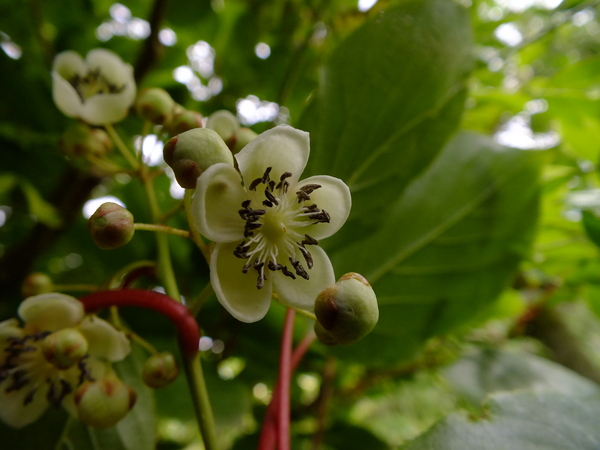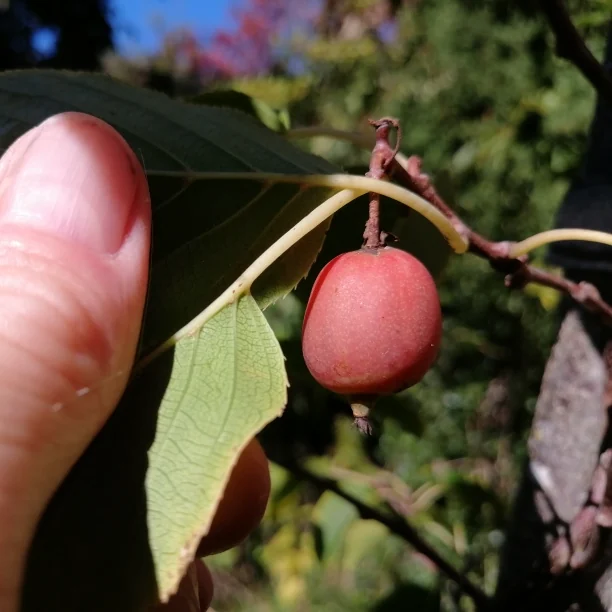Description of Actinidia arguta (Hardy Kiwi)
Actinidia arguta, commonly known as the hardy kiwi, is a fast-growing, deciduous climbing vine native to Asia. It produces small, smooth-skinned, grape-sized fruits that are sweeter and less tangy than regular kiwifruit (Actinidia deliciosa).
- Growth Habit: A vigorous vine that can grow up to 6–9 m annually when supported.
- Leaves: Bright green, heart-shaped, and about 8–12 cm long.
- Flowers: Small, fragrant white to cream flowers (1–2 cm in diameter), appearing in late spring (October–November in the southern hemisphere).
- Fruit: Smooth, edible skin; green flesh with small black seeds, ripening in late summer to autumn (February–April).
Propagation
1. By Seed
- Collection: Extract seeds from ripe fruit in late summer or autumn (March–April). Clean and dry the seeds.
- Stratification: Seeds require cold stratification at 1–5°C for 8–12 weeks. Store them in a damp medium like sand or sphagnum moss in the fridge.
- Sowing: Sow in late winter to early spring (July–August). Surface-sow seeds on a well-draining seed mix and lightly cover with fine sand. Keep soil moist and at 20–25°C for germination.
- Germination: Can take 1–2 months. Seedlings should be transplanted when large enough to handle.
2. By Cuttings
- Softwood Cuttings: Taken in late spring (October–November). Use shoots with 3–4 nodes, dip in rooting hormone, and plant in a moist propagation mix.
- Hardwood Cuttings: Taken in winter (June–July). Use mature wood, about 15–20 cm long, and plant in well-draining soil.
3. By Layering
- Bury a section of a vine in soil while still attached to the parent plant in late spring (October–November). Roots will form over a few months.
4. Grafting
- Commonly used in commercial production for consistent fruiting characteristics.
Cultivation
1. Climate and Soil
- Climate: Thrives in temperate regions with cold winters (for dormancy) and warm summers. Tolerates frosts but prefers protection from strong winds.
- Soil: Prefers well-drained, fertile, slightly acidic soil (pH 5.5–6.5). Ensure good drainage to avoid root rot.
2. Planting
- Plant vines in late winter or early spring (July–September).
- Use a sturdy trellis, pergola, or fence to support the vigorous growth.
- Space vines 3–5 m apart to allow for airflow and maintenance.
3. Watering
- Requires consistent moisture during the growing season. Avoid waterlogging.
4. Fertilizing
- Apply a balanced fertilizer in early spring and again in mid-summer (October–December). Avoid high-nitrogen fertilizers as they promote excessive vegetative growth at the expense of fruiting.
5. Pruning
- Prune in late winter (June–July) to remove dead or crossing branches and maintain the desired shape.
- Summer pruning (December–January) helps manage vigorous growth and improves sunlight exposure to developing fruit.
6. Pollination
- Hardy kiwi plants are usually dioecious, meaning separate male and female plants are needed for fruiting. Plant at least one male vine for every 6–8 female vines.
Uses and Benefits
1. Edible Fruit
- Hardy kiwis are eaten fresh, including the skin. They are also used in desserts, salads, jams, and smoothies.
2. Nutritional Value
- High in vitamin C, potassium, and dietary fiber. Rich in antioxidants and beneficial for digestion and immunity.
3. Medicinal Uses
- Traditional uses include promoting digestion and acting as an anti-inflammatory agent.
4. Aesthetic Value
- Its vigorous growth and attractive foliage make it an excellent choice for arbors, fences, and trellises, providing shade and privacy.
5. Wildlife Habitat
- The flowers attract bees, and the fruit is a food source for birds.

